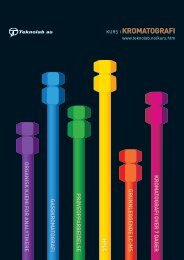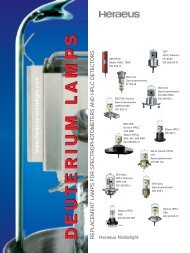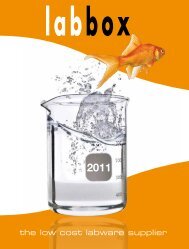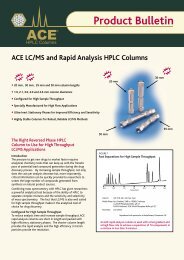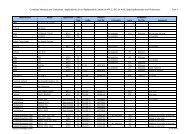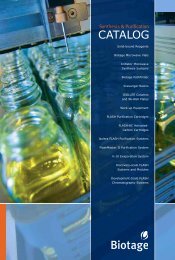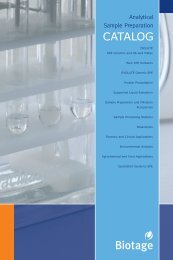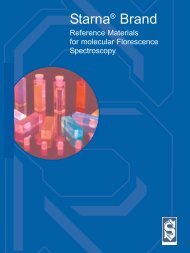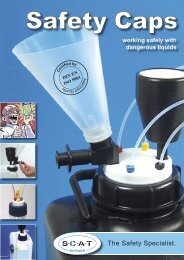GC - Teknolab AS
GC - Teknolab AS
GC - Teknolab AS
You also want an ePaper? Increase the reach of your titles
YUMPU automatically turns print PDFs into web optimized ePapers that Google loves.
gas chromatography<br />
Astec Chiraldex ® <strong>GC</strong> Capillary Columns<br />
• Resolve aromatic and nonaromatic enantiomers<br />
• Pure cyclodextrin derivative coating<br />
• No racemization of chiral stationary phase at elevated<br />
temperatures<br />
Chiraldex ® capillaries are based on derivatized cyclodextrins,<br />
which are chiral in nature formed by the -1,4 linkage of<br />
glucose units into toroidal shaped structures. The enzyme<br />
cyclodextrin glucosyl transferance (CGT) cleaves partially<br />
digested starch and links the glucose units into predominantly<br />
three forms, referred to as alpha, beta, and gamma; 6, 7,<br />
and 8 glucose units, respectively. These cyclodextrins are<br />
thermally stable, highly crystalline and virtually insoluble in<br />
most organic solvents. Using the three forms of cyclodextrin,<br />
Astec has manufactured derivatives that exhibit properties<br />
allowing them to be used as <strong>GC</strong> phases. They are:<br />
– Permethylated Hydroxypropyl (PH)<br />
– Dialkylated (DA)<br />
– Trifluoroacetylated (TA)<br />
– Propionylated (PN)<br />
– Butyrylated (BP)<br />
– Permethylated (PM)<br />
– Dimethylated (DM)<br />
– Dipropionyl (DP)<br />
The prefix A, B, G describes the cyclodextrins alpha,<br />
beta, and gamma, respectively. The suffix describes the<br />
nature of the derivatization i.e., G-TA refers to Gamma<br />
Trifluororacetylated phase.<br />
The most striking characteristic of these phases is that they<br />
separate nonaromatic enantiomers including saturated<br />
alcohols, amines, carboxylic acids, epoxides, diols, polyols,<br />
cyclic, bicyclic, heterocyclic compounds, lactones, amino<br />
alcohols, amino acids, halohydrocarbons, -halocarboxylic<br />
esters, pyrans, and furans. Little functionality is required for<br />
chiral recognition (Table 1). Also, there can be reversals of<br />
elution order from one series to the next as well as from one<br />
cavity size (beta) to another (gamma). The acylating reagent<br />
also can contribute to stereo-selectivity.<br />
technical assistance<br />
Contact Tech Support: Phone: 1.800.255.8324 (North America)<br />
Email: contact.alltech@grace.com<br />
Online: www.discoverysciences.com<br />
Table 1—General Classes of Compounds Separated on Chiraldex Capillary Columns<br />
Chiraldex ® A-PH: Smaller linear and saturated amines, alcohols, carboxylic acids, and epoxides<br />
Chiraldex ® B-PH: Most structural types of compounds including linear and cyclic amines and alcohols, carboxylic acids, lactones, amino alcohols, sugars,<br />
bicyclics, epoxides, haloalkanes, and more<br />
Chiraldex ® G-PH: Cyclic and bicyclic diols and other larger compounds including steroids and carbohydrates<br />
Chiraldex ® A-DA: Smaller cyclic amines, alcohols, and epoxides (Inquire regarding availability)<br />
Chiraldex ® B-DA: Nitrogen heterocyclics, heterocyclics, some bicyclics, and epoxides, lactones, aromatic amines, sugars, amino acid derivatives<br />
Chiraldex ® G-DA: Aromatic amines containing 2 or more rings, large cyclic diols, some heterocyclics, multi-ring compounds or compounds with bulky<br />
substituents<br />
Chiraldex ® A-TA: Smaller alcohols, amino alcohols, amino alkanes, and diols<br />
Chiraldex ® B-TA: Broad range alkyl alcohols, halo acid esters, amino alkanes, halocycloalkanes, certain lactones, diols, alkyl halides, furan and pyran<br />
derivatives<br />
Chiraldex ® G-TA: >350 pairs chiral alcohols, diols, polyols, hydrocarbons, lactones, amine alcohols, halocarboxylic acid esters, homologous series, furan<br />
and pyran derivatives, epoxides, glycidyl analogs, and haloepihydrins<br />
Chiraldex ® G-PN: Epoxides, higher alcohols >C4, lactones<br />
Chiraldex ® G-BP: Amino acids, certain primary amines and furans<br />
Chiraldex ® G-DM: Selectivity similar to PM and PH, but with shorter retention times, and greater resolution. Especially applicable to aliphatic, olefenic, and<br />
aromatic enantiomers<br />
Chiraldex ® B-PM: Acids, alcohols, barbitals, diols, epoxides, esters, hydrocarbons, ketones, lactones, and terpenes<br />
Chiraldex ® B-DM: Selectivity similar to PM and PH, but with shorter retention times, and greater resolution. Especially applicable to aliphatic, olefenic, and<br />
aromatic enantiomers<br />
Chiraldex ® B-DP: Aromatic and aliphatic amines and some aliphatic and aromatic esters<br />
Chiraldex ® G-DP: Aromatic and aliphatic amines and some aliphatic and aromatic esters<br />
gc columns | capillary<br />
www.discoverysciences.com<br />
235




